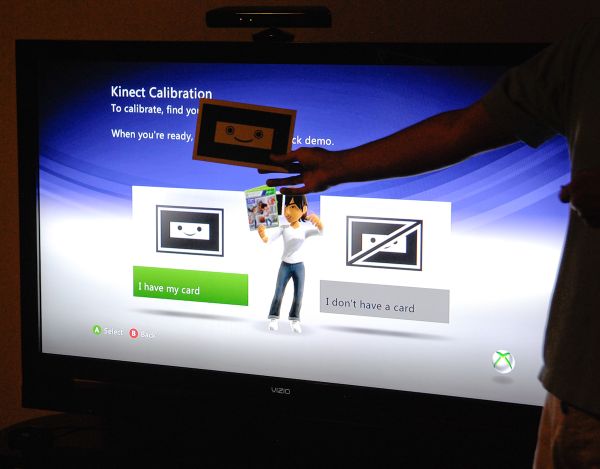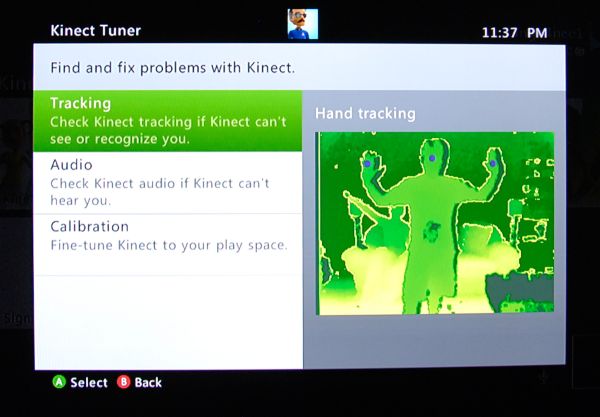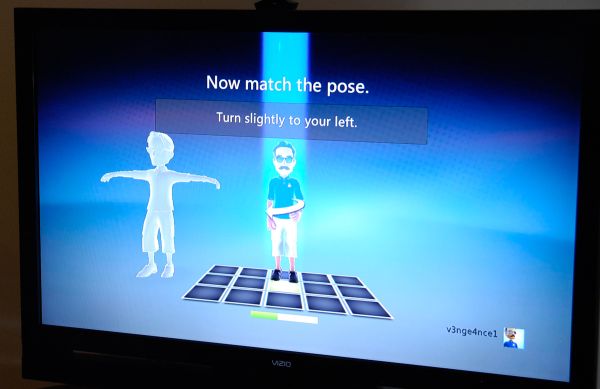Microsoft Kinect: The AnandTech Review
by Brian Klug on December 9, 2010 3:20 PM ESTSetup and Calibration
The first time you connect and fire up your console (Xbox 360 or Xbox 360 S), you get to go through the setup wizard. If you don’t have Xbox Live, you’re told to sign up for a trial period and that you really should get it so you can download necessary updates. Actually, even before the trial wizard pops up, you’re prompted to install a necessary update if you somehow don’t have the tweaked Xbox 360 dashboard (NXE 2.0?).
After that, you’re told to position the sensor appropriately, check background sound, calibrate the array microphone, and then decide whether you want to use the Kinect microphone for Xbox Live party chat. The first time I ran through this wizard, it complained to me that the room was too loud - in complete silence. I think that me snapping photos was loud enough to trigger it, but they’re not messing around with wanting you to be quiet during the calibration routine. Moreover, this is important so the smart microphone system can build a profile out for the room, and probably cancel the game sounds themselves. On my 5.1 system each channel played a tone twice.
The setting to pay attention here is whether or not you truly want your Kinect to be the party chat device. Turn it on, and you’ll default to using this microphone array in online matches instead of an earpiece which you can easily mute - in fact, this is really the only inconvenience. If you turn this off, you’ll also find that later on you can’t use Kinect Video chat - more on that later. The setup tutorial also tilts the sensor appropriately depending on whether you’ve put the sensor on top or below of the display.
After the wizard completes, you’re left thinking that it’s finished. Instead, it starts a training tutorial that tells you to move all your furniture, remove any extraneous friends from the field of view of the Kinect, and walks you through interaction. What’s unnerving about this tutorial is that it requires the controller - that just doesn’t seem right. It makes even less sense given the first setup wizard’s insistence that you put down the controller, even showing a no-controller symbol if you try and mash buttons. But it walks you through the basic interactions which I’ll summarize in a second. If you’re dying to see every step of setup, they’re in the gallery below.
The Kinect tuner essentially lets you run the audio calibration, tilt, and room calibration again. There’s a card which ships with Kinect Adventures (and you can purchase online, seriously) that has a happy face.
The tuner takes requires you to hold the calibration smiley card in a variety of positions that line it up with on-screen sunglasses. This calibration routine requires lots of ambient light as it seems to use both the depth and color cameras.
The final (optional) Kinect training is auto-login facial recognition. It’s a pretty cool concept - step in front of the Xbox in a Kinect enabled game or situation, and you’re automatically signed in under the appropriate gamertag.
The facial recognition training requires you to stand in a variety of different places throughout the room and match a pose. It’s a bit confusing that facial recognition requires hand gestures, but I’m guessing this is just to keep the ADD sensibilities appeased. You walk around, turn slightly, and stand in the appropriate place until told to move. Kinect basically needs to build a 3D profile of your face since its facial recognition algorithm uses both depth and color cameras to build your profile.
In practice I found auto login to work without fuss almost all of the time. Step into the field of view of the sensor, and you’ll get a recognizing prompt to the left of the depth camera image, and if successful a “welcome back, [gamertag]” message. I only had auto login fail once or twice when the room was very dark, and once when I moved the Kinect to a completely different location before running the tuner again.




















72 Comments
View All Comments
Noriaki - Thursday, December 9, 2010 - link
Yeah, I just meant the 350 part. Referring to it as the 360 S to distinguish it from the 360 Pro makes sense to me.Noriaki - Thursday, December 9, 2010 - link
PS: Thanks for the in-depth coverage. This is the first time I feel like I got a good idea of what having a Kinect in my living room would mean for practical things like where my couch lives.Aikouka - Thursday, December 9, 2010 - link
Brian, have you tried out DanceMasters (DM)? I noticed you commented on how your girlfriend compared Dance Central (DC) to DDR where DanceMasters is actually created by Konami.I own DM and have played the DC game, and I have to say... you'd probably be disappointed in the DM menu system as it is a tad bit harder to control. Way too often I found myself skipping past the option I wanted (as all options move left or right) and you then have to raise your (right) hand to select it. The problem comes when it might see you move your hand out to the right and actually shift your choice over one right before you raise your hand.
The part where I think DM beats DC is the actual dancing. In the demo for DC, I found it awkwardly difficult to pay attention to the way the dancer was moving (left or right, etc) and the upcoming movement that was shown on the right side of the screen. When my brother and his girlfriend played, I noticed one huge trend... we *all* would miss the first dance move after they changed from one move to another.
This is kind of better in DM, because it uses arrows that signify how your hand (or hands) should move in a second or two. There are also circles that will appear on the screen and you must hit them with either your hands or feet (obvious depending on the location). The last movement is the "pose silhouettes" that appear on the left and right side and are green in color. They move to the center of the screen and when the two silhouettes combine, you are supposed to be in that pose. The only problem is that it's not terribly picky on what you do in between these three types of inputs and another problem is that it loves to put circles beneath your feet (so you keep moving), but they're hard to notice. I found this easy to combat by simply always moving your feet.
Overall, there's a huge difference in the style of music between the two as well, which influenced my decision. I've never been a "Top 40s" kinda guy and I've played DDR quite a bit, so I went with the game that had the music style I was used to ( and also considering that I've heard quite a bit of Eurobeat, which DM also has ).
The one thing that was always fun about DC was the "freestyle" section where it shows you as this sort of glowing silhouette and you just do whatever dance you want. At the end, it will play this back to you in a sort of time-lapse video (which you can then save).
To talk about a different game, I noticed some problem with jumping in Kinect... mostly in the rail-based obstacle course. Maybe I was just doing little hops and Kinect didn't register it... maybe it was a problem with the cargo pants (khaki color, so they're fairly flesh-toned) that I was wearing. It was pretty crazy though... at one point I had to duck down, so I dropped to my knees and then needed to switch sides, so I pulled out the Starfox-esque barrel roll! Kinect did actually sense that correctly.
The one thing I did notice is that it is *very* common in Kinect Adventures for it to yell at me about getting too close or too far... especially in the bubble popping mini-game.
Brian Klug - Thursday, December 9, 2010 - link
I haven't checked out Dance Masters, but I'm starting to think that I definitely should. I think at the time when I originally put together this list of games, that wasn't available and I overlooked it. I'll grab it and maybe update with a page or two.It's interesting how dancing games are quickly becoming something Kinect is very well suited for. I definitely agree about jumping and the clothing choice, I have a pair of cargo shorts that just don't work with most of the titles, and Kinect Adventures does yell a lot about position, agreed.
-Brian
GSJ - Thursday, December 9, 2010 - link
If only i could use this with my p.c.....ExarKun333 - Thursday, December 9, 2010 - link
I purchased the Kinect soon after the launch and I came to pretty much the same conclusions are Brian. The lag is there, but acceptable. More importantly, the games are FUN. MS did a great job with this launch. The hardware is easy to install and configure, and the games are easy to pick up on. I agreed 100% that the menus in DC are superior to the method in the Dashboard. Maybe an update at some time? :)knowom - Thursday, December 9, 2010 - link
267ms on a DAW would be completely unthinkable in fact most people that play or record music try to stay below 10ms.I'm just using that example as a clear easy to demonstrate reason to why 267ms is a abysmal amount of input lag you can completely rule out music based kinect games as well as any twitch/quick reflex input games or applications.
SodaAnt - Thursday, December 9, 2010 - link
In the comment about the laser probably being 650-700 nm, that is wrong. 650nm is the wavelength of a normal red laser pointer. Normal IR diodes lase at either 780, 808 or 980nm.Brian Klug - Thursday, December 9, 2010 - link
Hmm it's on the fringes of what I'd consider visible, but 780 probably is a much better choice. I'll update.-Brian
mcnabney - Thursday, December 9, 2010 - link
Okay, I am probably the only prig to bring this up, but the distances required seem to be a problem for some not often thought of reasons.9-12 feet of clearance appears to be required, which means the sofa will need to be 15' back (unless you move it every time you fire up the Kinnect).
I would point out that you would need to have a 55"+ HDTV to fully benefit from the 1080p image from the Kinnect playing area, For regular game playing / movie watching on the sofa (behind the playing area) you would require a 100"!!!!! screen to fully resolve the 1080p image that the Xbox360 or a BluRay player is capable of displaying.
For this thing to really work in a robust media environment (and most living rooms) it should have been able to to work perfectly with the user standing 3-5' from the screen.